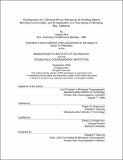Development of a "genome-proxy" microarray for profiling marine microbial communities, and its application to a time series in Monterey Bay, California
Author(s)
Rich, Virginia Isabel
DownloadFull printable version (30.98Mb)
Other Contributors
Woods Hole Oceanographic Institution.
Advisor
Edward F. DeLong and George Somero.
Terms of use
Metadata
Show full item recordAbstract
This thesis describes the development and application of a new tool for profiling marine microbial communities. Chapter 1 places the tool in the context of the range of methods used currently. Chapter 2 describes the development and validation of the "genome proxy" microarray, which targeted marine microbial genomes and genome fragments using sets of 70-mer oligonucleotide probes. In a natural community background, array signal was highly linearly correlated to target cell abundance (R² of 1.0), with a dynamic range from 10²-10⁶ cells/ml. Genotypes with >/=~80% average nucleotide identity to those targeted crosshybridized to target probesets but produced distinct, diagnostic patterns of hybridization. Chapter 3 describes the development an expanded array, targeting 268 microbial genotypes, and its use in profiling 57 samples from Monterey Bay. Comparison of array and pyrosequence data for three samples showed a strong linear correlation between target abundance using the two methods (R²=0.85- 0.91). Array profiles clustered into shallow versus deep, and the majority of targets showed depth-specific distributions consistent with previous observations. Although no correlation was observed to oceanographic season, bloom signatures were evident. Array-based insights into population structure suggested the existence of ecotypes among uncultured clades. Chapter 4 summarizes the work and discusses future directions.
Description
Thesis (Ph. D.)--Joint Program in Biological Oceanography (Massachusetts Institute of Technology, Dept. of Biology; and the Woods Hole Oceanographic Institution), 2008. This electronic version was submitted by the student author. The certified thesis is available in the Institute Archives and Special Collections. Includes bibliographical references (p. 155-181).
Date issued
2008Department
Joint Program in Biological Oceanography.; Woods Hole Oceanographic Institution; Massachusetts Institute of Technology. Department of BiologyPublisher
Massachusetts Institute of Technology
Keywords
Biology., Joint Program in Biological Oceanography., Woods Hole Oceanographic Institution.